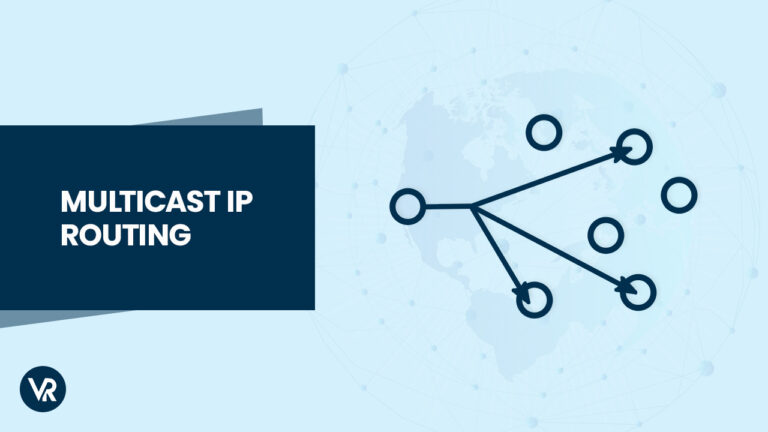
IP Multicast Routing efficiently delivers large amounts of data from one source to multiple destinations simultaneously. It is commonly used for streaming video and audio, online gaming, and other applications that require high-performance delivery of content over the internet. Multicast IP routing allows packets to be sent only once while replicated at each step to their destination, reducing network overhead and increasing performance.
Multicast IP routing efficiently delivers large amounts of data from a single source to multiple destinations simultaneously. Unlike broadcasting, which sends a message to all addresses on a network segment, multicast will Change IP Address from Command Prompt at each step along its route to its destination, thereby reducing network overhead and improving performance.
Unicast, on the other hand, involves the routing of an IP packet from one source to one destination through routers. This is the traditional method for transporting packets over the internet.
This article will discuss the basics of multicast IP routing, such as what it is and how it works. Additionally, we’ll discuss the benefits of using multicast IP routing and some potential challenges with implementing it. After reading this article, you should better understand IP Multicast Routing and how it can benefit your network. Let’s get to the details.
Multicast IP Basics: IP Multicast Routing
IP Multicast routing has several acronyms and terms that apply to rooting devices and networks. A Multicast group is a set of receivers programmed to receive a particular data set. The hosts receiving the data must join this group using the Internet Management Protocol (IGMP).
The main purpose of the routing device in IP Multicast is to create a distribution tree that will connect servers to the sources. This tree will have the source as its root.
The Upstream interface leads to the source in the routing device. On the other hand, the Downstream interface leads to the receivers in the routing device. One routing device can have various downstream interfaces at a go.
The upstream interface is commonly referred to as the “incoming” interface, whereas the downstream interface is known as the “outgoing”. Most vendors use the incoming and outgoing labels in their CLI outputs.
There are different types of IP Addresses . However, multicast uses the Class D IP Address Classes from 224.0.0.0 to 239.255.255.255, where the source of any multicast packet is a unicast IP address, and its destination is always a multicast address.
Here is how the Class D range is split:
| Description | Range |
| Link Local Addresses | 224.0.0.0/24 |
| Globally Scoped Addresses | 224.0.1.0 – 238.255.255.255 |
| Source-Specific Multicast | 232.0.0.0/8 |
| GLOP Addresses | 233.0.0.0/8 |
| Limited Scope Addresses | 239.0.0.0/8 |
The Link-Local Address range is for the network routing protocols for the local network. A Router will never forward packets with these IP addresses.
If using IPv6, the ff00::/8 prefix is used. Like IPv4, specific multicast ranges are used for special purposes, with some having IPv4 equivalents while others only contain IPv6. These reserved IPv6 multicast addresses are defined by special protocols, including OSPFv3, EIGRP, RIP, and PIM. Layer 2 multicast deals with MAC addresses.
Reverse Path Forwarding
Reverse path forwarding is a methodology used in multicast networks to control data flow. In this technique, each router examines the source address of incoming packets and compares it with its address. If there is a match, the packet will be forwarded. Otherwise, it will be dropped. This ensures that loops do not occur within the network layer and helps maintain efficient use of bandwidth resources.
The router quickly reads the first entry for a given upstream interface and sends the packet to its respective downstream counterpart. But that’s not all; it must also consider multiple records associated with that same upstream interface.
Assembling the Routing Table
The routing table for destinations of multicast packets is created upon request. This is the same as a subscription service, where the endpoints expecting to receive packets from the multicast source notify the router of their interest.
Instead of the multicast source informing the router which destinations should receive its packets, each recipient sends a message requesting a copy of anything the router receives from the source. This is known as reverse path forwarding since the route is generated not as a push-out to a destination but rather as a pull-in from the source.
IP Multicast Routing Protocols
There are two phases in creating a multicast path. The first is the subscription process, where recipients will register their IP address, outlined in the Internet Group Management Protocol (IGMP), operating for the IPv4 addresses. The IPv6 address is dictated by the Multicast Listener Discovery protocol (MLD). The multicast forwarding process is called “multicast group membership discovery protocols.”
Although several multicast group membership discovery protocols exist, two of the most widely used today are IGMP and MLD. In addition, many hypothetical protocols are currently being explored for the following stage of multicast routing. Nevertheless, the system now utilized by almost all routers is Protocol Independent Multicast (PIM).
Packet Duplication
Packet duplication only occurs when the pathways to the receivers diverge. Thus, routers read the interface name from their routing table instead of destination addresses. When numerous recipients are beyond a single router, the forwarding router will send out one copy of data to its corresponding intermediate router. All routers have separate entries for multicast routes inside their respective routing tables.
By using interfaces rather than addresses when sending multicast packets, the result is that those packets only get duplicated if multiple paths branch out for different recipients. For instance, if five recipients are beyond one neighboring router, the forwarding router will send one copy to that neighbor. This will keep traffic to a minimum, known as “sparse mode multicast routing.”
Dense Mode Multicast Routing
Sparse mode multicast routing is used to keep the traffic to a minimum. Besides this, there is another forwarding method, “dense mode multicast routing,” which you need to know about. This dense mode is used to simplify the reference to routing cables. Practically, this method will build up the same as sparse mode.
The dense mode is commonly referred to as flooding, and the opt-out signal sent by routers is known as “prune message” or “pruning.”
Below are the protocols that employ dense mode:
- Distance Vector Multicast Routing Protocol (DVMRP)
- Multicast Open Shortest Path First (MOSPF)
- PIM Dense Mode
It is best to avoid using dense mode when implementing a routing table, as this can potentially cause feedback loops and other issues. While it may rapidly populate the routing table, this approach carries greater risks for instability in the system.
IP Multicast Routing on the Internet
Multicast routing is not only for private networks but can work even on remote sites and clients within the methodology. Various businesses are now employing multicast routing. These include:
- IPTV
- Online training courses.
However, it is advisable to use a cloud-based multicast platform rather than the traffic from your network to ensure the traffic is routed through the most efficient path. And if your security is your concern, you can always rely on the best Cloud VPNs .
IP Multicast Routing Considerations
If you want to improve your network but are cash-strapped, you should consider implementing traffic-shaping measures, which include Class-based Quality of Service (QoS). This is an inexpensive way to prioritize certain multicast data over other traffic, such as email or web surfing.
Investing in a dependable network traffic analyzer is essential to measure bandwidth utilization and analyze new scenarios. Utilizing the right tool will make it easier to gain insight into your current use cases and plan for any potential problems or opportunities.
As a preventative measure, you should also install a network monitor to keep watch over the health of your network devices and keep off any potential points of failure.
FAQs: IP Multicast Routing
What is the purpose of multicast IP ?
Multicast IP sends data from one source to multiple destinations over a network. It allows for the efficient and effective distribution of multimedia content across large networks, such as audio and video streams. By using multicast IP, you can send out a single media stream to all required destinations without the need for separate transmissions for each destination. This reduces bandwidth and can bring significant cost savings for large streaming projects.
Should I enable multicast routing ?
Yes, Multicast routing offers efficiency in comparison to unicast routing. All devices will receive the stream regardless of whether they have joined a particular multicast group. Only those that desire the broadcast will be added to a given multicast group, thus creating an efficient use of available network resources. That is why many networks favor multicast routing because it’s more effective.
How do I know if an IP address is multicast ?
Multicast IP addresses always begin with the number “224” in the first octet. The range of multicast IP addresses is from 224.0.0.0 to 239.255.255.255, inclusive. You cannot use a Multicast address as a source for any traffic.
What are the advantages of Multicast ?
Multicast enables the efficient and effective distribution of multimedia content across large networks . It reduces network traffic because it only sends one stream copy to all the destinations that require it instead of sending multiple copies as with unicast communication. Multicast also reduces bandwidth consumption, making it more cost-effective for streaming projects. Multicast enables video conferencing and other real-time applications to be more effective.
Is Multicast a security risk ?
No, Multicast does not generally present any security risks . However, ensuring that the network is configured correctly and protected from malicious actors is essential. Firewall rules should be in place to block access from unauthorized sources, and you should use strong authentication for all user accounts. Additionally, it would be best if you used proper authorization control to limit access to multicast resources.
Conclusion
IP Multicast Routing provides an efficient and cost-effective way to deliver multimedia content across a network. You must configure the network appropriately and securely to ensure optimal performance and prevent any malicious actors from accessing the content.
Additionally, organizations can ensure they are making the most of their network resources by understanding the range of multicast IP addresses and their advantages. Use this information to improve the performance of your network and reduce costs associated with streaming multimedia content.
